Have you ever seen plating corals while scuba diving? We also call them lettuce corals, cabbage coral, scroll coral, or plate coral because of their unique plating or foliose growth form.
Plating corals attach to the rocks either at the center of the coral or on one edge. These corals don't waste time — once attached they begin reaching for the sunlight and growing outwards and upwards.
Identifying plating coral
The plates can be wide and smooth like a dinner plate, or leafy and crinkled like the edges of a lettuce leaf. These species of coral have adapted to living deeper on reef slopes by spreading out their skeletons. Consequently, they can capture more light, which feeds the photosynthetic algae living inside their tissue. The unique plating and foliose shape can also help trap particles of food passing in the current.
The thinner plates grow quickly, and with optimal conditions, some species like Echinopora can grow a few centimeters per month. In contrast, plates like Turbinaria might only grow a few centimeters per year depending on their age.
If you're new to coral identification, look at part one and part two of our coral biology series. These will help you learn the basics of coral biology, as well as some helpful terms for identification. And if you're new to Indo-Pacific coral identification, check out our introduction to hard corals of the Indo-Pacific.
Here are five common genera of plating corals you can find while scuba diving in the Indo-Pacific.
Montipora
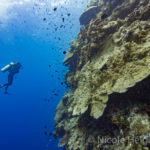

Montipora is the master of disguise and comes in just about every growth form imaginable. Plating Montipora makes up the bulk of all reef-building corals especially as you head down the reef slope. Montipora has small corallites that are embedded in the surface of the coral, usually between ridges. Montipora can be many different colors and you must look closely at the polyps to spot ones with contrasting colors from the coral tissue. Montipora can also exhibit a combination of growth forms; some of the colony can be encrusting and then turn into a plate. This coral also occasionally grows branches from the plate.
Acropora
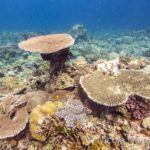

While the majority of Acropora are branching, a few species are plating. Some Acropora species have branches that extend to the side instead of straight up. Sometimes the branches are widely spaced as well, so the colony resembles a lattice. At other times the branches are completely fused together. You can tell the coral is an Acropora by looking for the axial corallite. Check out our article about branching corals for more details about this important genus of coral. Together Acropora and Montipora make up one-third of all reef-building species.
Echinopora

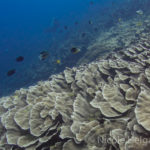
Echinopora forms thin plates with extensive colonies that can dominate reef slopes. Identify Echinopora by looking at the top of the plate for round, dome-shapes corallites dotting the coral's surface. Echinopora has distinct corallites that can align in rough lines or a random pattern, but there will always be gaps between each one. Be careful around Echinopora as this coral is quite fragile.
Turbinaria

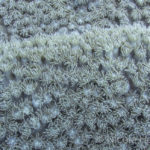

Turbinaria coral was one of the first genus of coral scientists learned to identify. It really stands out with large polyps that extend during the day. You'll easily spot the bright yellow Turbinaria scroll coral. This coral forms thick, sturdy plates, and a mature colony is quite robust. Nonetheless you should always avoid touching corals, as even the smallest touch will remove protective mucus covering the coral's surface.
Mycedium
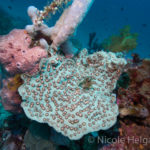

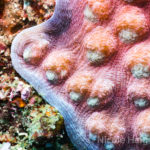
Mycedium is also quite easy to identify. You can recognize this coral by the nose-shaped corallites that always point toward the outside of the colony. Mycedium corals can grow as a single plate or large colonies that can dominate reef slopes. You can often find Mycedium, Echinopora and Turbinaria corals growing together. Mycedium corals however, are much brighter in color than Echinopora, or Turbinaria. Be on the lookout for Mycedium with three or four colors with brightly colored oral disks inside the corallites.
The post Introduction to Plating Corals of the Indo-Pacific appeared first on Scuba Diver Life.
from Scuba Diver Life https://ift.tt/2P8JhwQ
No comments:
Post a Comment